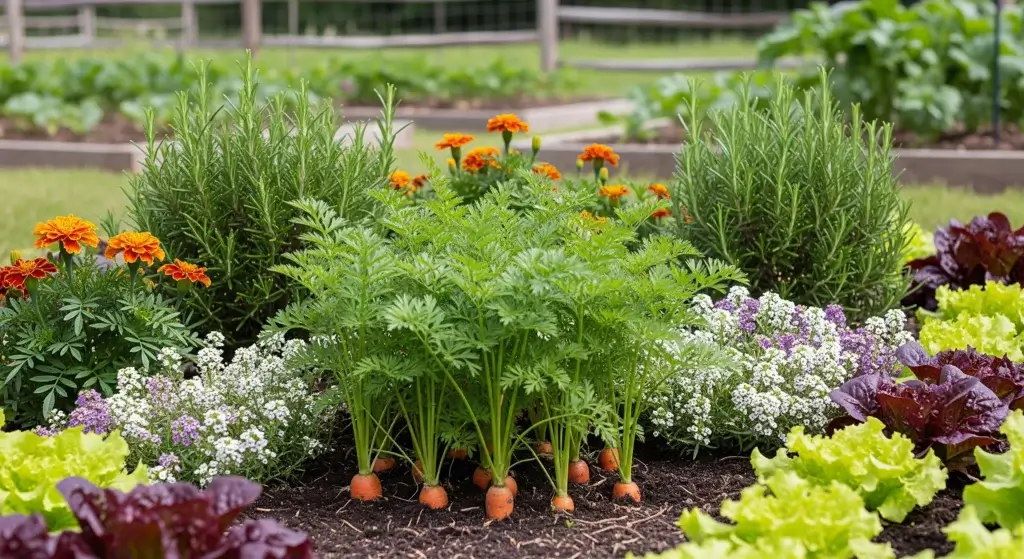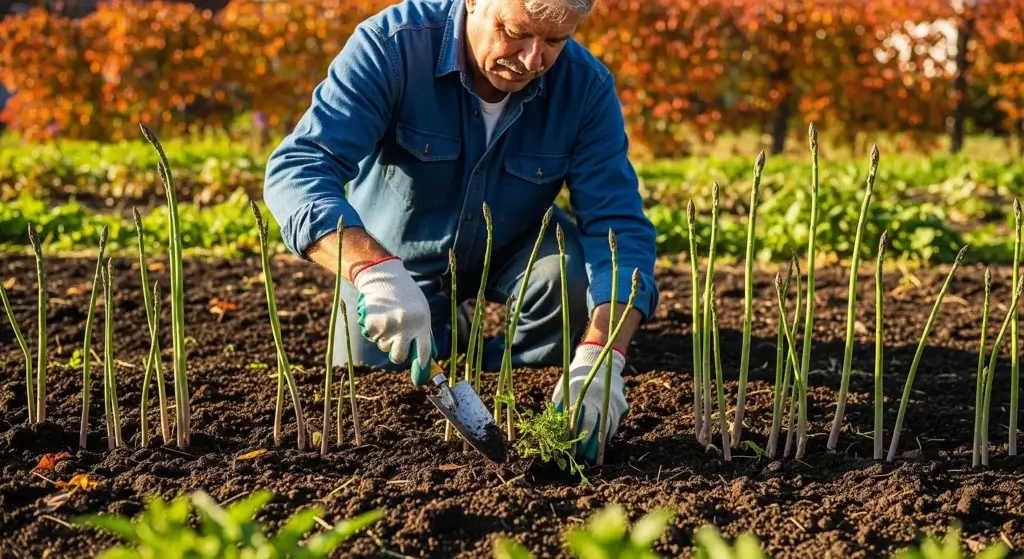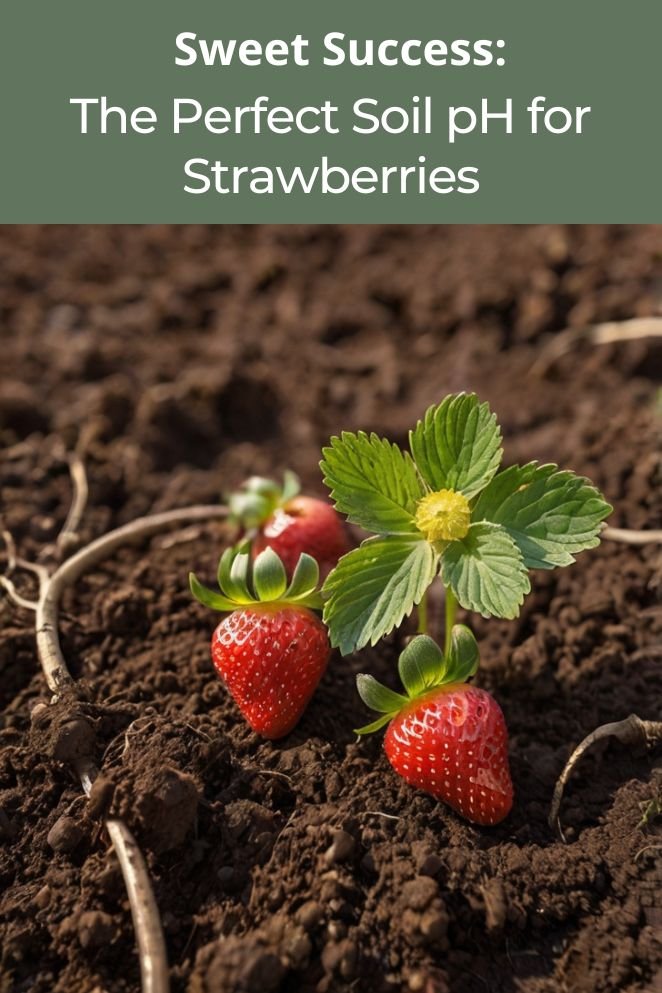
Strawberries are not only delicious but also relatively easy to grow with the right conditions.
One crucial aspect of creating the perfect environment for your strawberry plants is maintaining the correct soil pH.
The ideal soil pH for strawberries is slightly acidic, keeping your soil acidic ensures your plants can absorb nutrients efficiently, leading to healthier growth and more abundant fruit production.
In this comprehensive guide, we’ll dive into everything you need to know about soil pH and its impact on strawberry plants.
From understanding the ideal pH range to testing and adjusting your soil, we’ve got you covered.
Effects of Soil pH on Plants
Plants are like picky eaters. They need the right nutrients in the right forms to thrive.
Soil pH plays a crucial role in how these nutrients are available.
Soil pH measures how acidic or alkaline your soil is.
A pH of 7 is considered neutral, while lower numbers indicate acidity and higher numbers mean alkalinity.
Here’s how soil pH impacts your plants:
- Read also: Step by Step: Easy DIY Vertical Garden For Strawberries
- Read also: Stress-Free Winterizing: Tips on How to Overwinter Strawberries
Nutrient availability
This is a big one. Soil pH affects the solubility and availability of minerals and nutrients.
Most nutrients are more readily available in acidic to neutral soils (pH 5.5-7.0).
Extreme pH levels (very acidic or alkaline) can lock up essential nutrients like phosphorus, magnesium, and iron, making them unavailable for plant uptake.
This can lead to deficiencies and stunted growth.
Microbial activity
Soil teems with microscopic life that helps break down organic matter and releases nutrients for plants.
Beneficial microorganisms are hindered in strong acid soils, leading to nutrient deficiencies.
The right pH range (generally between 6.0 and 7.0) fosters a healthy microbial community, optimizing nutrient cycling for your plants.
Nutrient toxicity
Soil pH can also lead to nutrient toxicities, which occur when certain elements are too available and reach toxic levels:
- Acidic soils: High aluminum (Al) levels in acidic soils can be toxic to plant roots, inhibiting root growth and function. While manganese (Mn) is less available in alkaline soils, it can reach toxic levels in very acidic soils, damaging plant tissue and leading to brown spots on leaves.
- Alkaline soils: High pH often correlates with high sodium (Na) levels, which can cause salt stress, leading to leaf burn and reduced plant vigor.
Plant disease susceptibility
Soil pH can influence the occurrence and severity of plant diseases:
- Acidic soils: Pathogens like certain fungi and nematodes thrive in acidic conditions, increasing the risk of root diseases and other infections.
- Alkaline soils: High pH can exacerbate issues with bacterial wilt and other diseases that prefer less acidic conditions.
Physical soil properties
Soil pH can impact the physical characteristics of the soil, affecting plant growth indirectly.
Acidic soils often have poor structure and drainage, which can lead to waterlogging and root rot.
Conversely, very alkaline soils can become compacted and hard, making it difficult for roots to penetrate and access water and nutrients.
Extreme pH levels can alter the soil’s ability to retain water.
Acidic soils may dry out quickly, while alkaline soils may not hold water efficiently, both conditions stressing the plants.
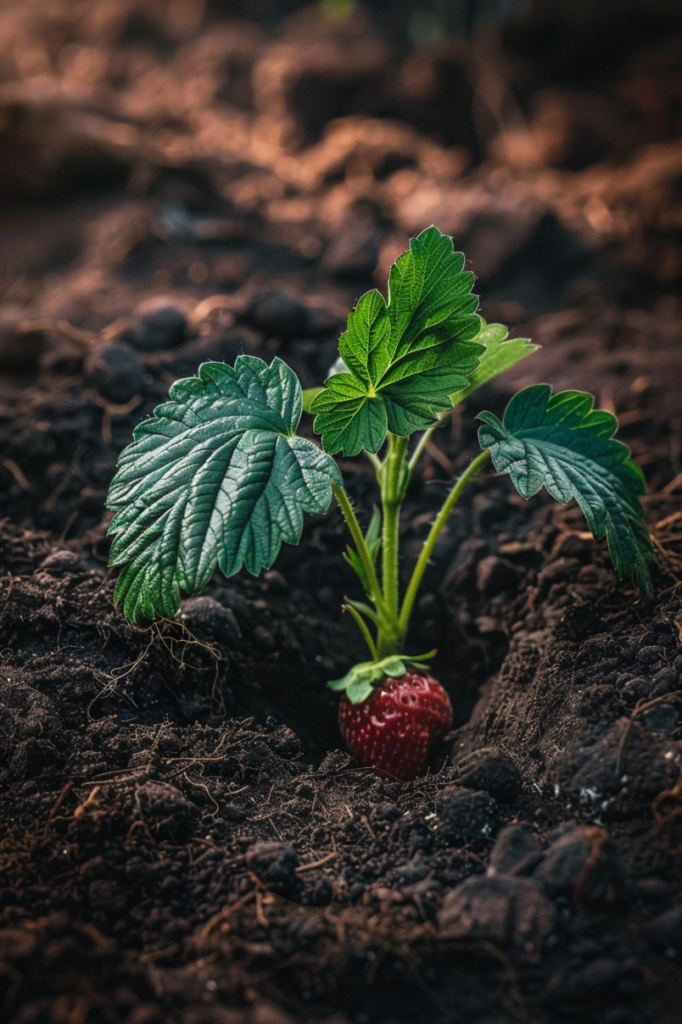
The Ideal Soil pH for Strawberries
Strawberries thrive in slightly acidic soil with a pH between 5.5 and 6.5.
Within this range, strawberry plants can access all the nutrients they need for optimal growth and fruit production.
If your soil pH falls outside this range, you may need to make adjustments to ensure your strawberry plants can flourish.
If your soil pH is not within the ideal range, your strawberry plants may show signs of distress. Common symptoms include:
- Yellowing leaves: This can indicate nutrient deficiencies caused by improper pH levels.
- Stunted growth: Plants may grow more slowly or produce fewer runners.
- Poor fruit production: Low yields or small, misshapen berries can result from nutrient imbalances.
- Leaf burn or marginal necrosis: Edges of leaves may turn brown or die back.
How to Test Soil pH
Testing your soil pH is the first step in ensuring your strawberries have the ideal growing conditions.
There are several methods to test soil pH, ranging from simple DIY kits to professional laboratory analyses.
DIY soil pH test kits
You can find soil pH test kits at most garden centers or online.
These kits typically include test strips or a liquid solution that changes color based on the pH of your soil.
To use a DIY test kit:
Step 1: Collect a soil sample
Dig small samples from several areas of your garden to get an accurate reading.
Step 2: Mix and prepare the sample
Combine the samples in a clean container and remove any debris.
Step 3: Test the soil
Follow the instructions on your test kit, which usually involves adding soil to a test tube and mixing it with a solution.
Step 4: Read the results
Compare the color change to the provided chart to determine your soil’s pH.
Professional soil testing
For more accurate results, consider sending a soil sample to a professional laboratory.
Many universities and agricultural extension offices offer soil testing services.
These tests provide detailed information about your soil’s pH and nutrient levels, helping you make more informed decisions about amendments and fertilization.
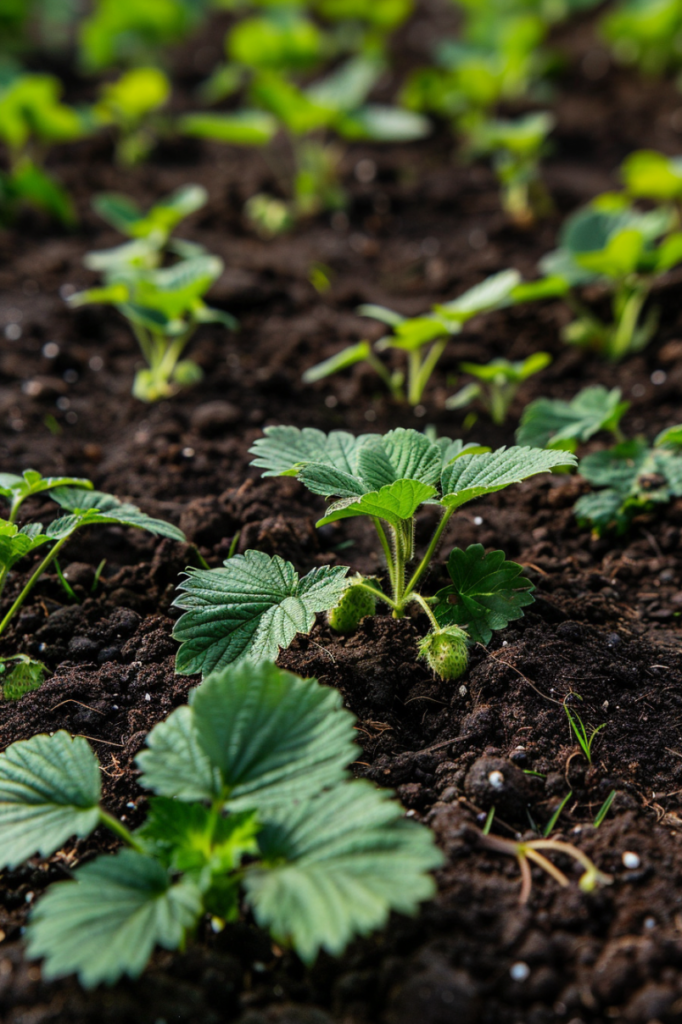
Adjusting Soil pH
If your soil pH is outside the ideal range for strawberries, you’ll need to adjust it.
The method you use will depend on whether you need to raise or lower the pH.
Lowering soil pH
If your soil is too alkaline (above 6.5), you’ll need to lower the pH to create a more acidic environment.
Common methods include:
- Commercially available options
- Elemental sulfur: A slow-reacting method that requires biological processes to lower pH, taking 3 to 6 months to complete.
- Aluminum sulfate: Fast-reacting but toxic to plants and requires more product to achieve the same effect as elemental sulfur.
- Iron sulfate (Ferrous sulfate): Fast-reacting but more expensive than elemental sulfur.
- Natural soil acidifiers
- Peat moss: Effective for sandy soils, but temporary and less effective than other methods.
- Compost: Releases organic acids over time, but the amount is smaller compared to other methods.
- Fertilizers
- Ammonium-containing fertilizers: Lower soil pH by releasing sulfuric acid, but ammonium nitrate has a smaller impact if used in lesser amounts.
Raising soil pH
When your soil’s pH drops below 5.5, it becomes too acidic for most plants.
To correct this, you’ll need to raise the pH and make the soil more alkaline through a process called “liming”.
Here are some effective ways to increase soil pH:
- Lime-based materials
- Dolomite lime: Commonly used by farmers and gardeners to decrease acidity, but avoid using it if the soil has high magnesium levels.
- Agricultural lime: Made from pulverized limestone/chalk, but may contain other chemicals.
- Hydrated limestone: Fastest method but can be easy to overdose.
- Organic methods
- Baking soda: Gentle and cost-effective method, but may not be as effective as lime-based methods.
- Pulverized eggshells: High in calcium content, making them a good alternative to lime.
- Wood ashes: Can raise pH quickly but has limited long-term effects.
- Other methods
- Oyster shell lime: Organic and contains up to 39% calcium, making it suitable for calcium deficiencies.
- Crushed eggshells: Can be used in compost bins for a gradual release of alkaline materials
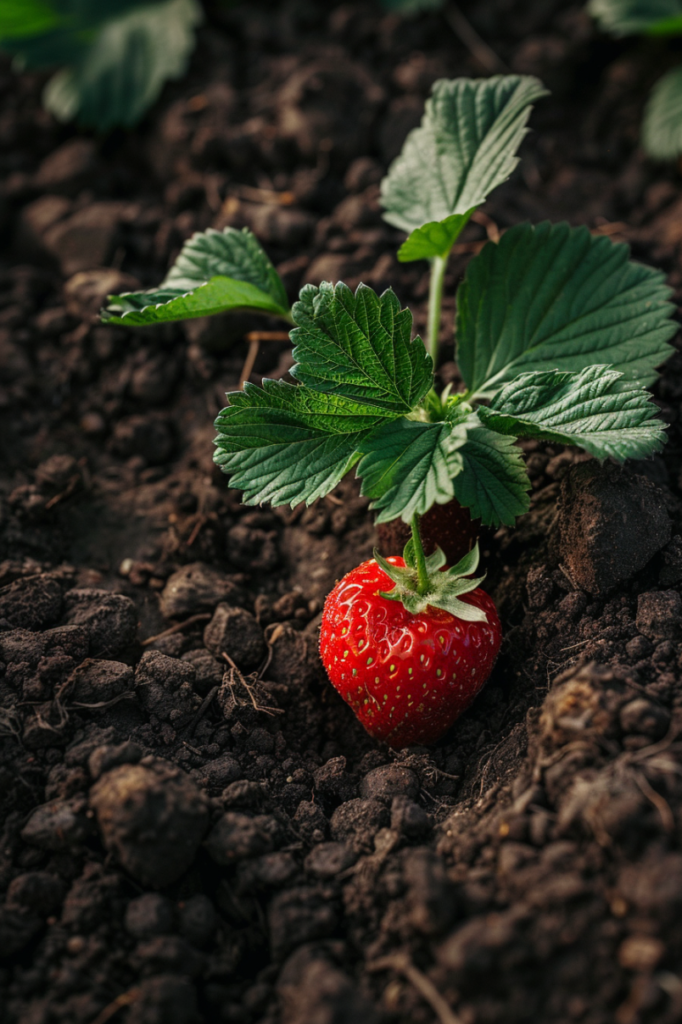
- Read also: Cracking the Code: Understanding Soil pH for Luscious Tomatoes
- Read also: Is Your Soil pH Right for Blueberries? Here’s How to Find Out!
Conclusion
Maintaining the proper soil pH is crucial for growing healthy and productive strawberry plants.
By regularly testing your soil and making necessary adjustments, you can ensure your strawberries have the ideal conditions for optimal growth and fruit production.
Remember, a slightly acidic soil pH between 5.5 and 6.5 is the sweet spot for strawberries.
With a little attention and care, you can enjoy a bountiful harvest of delicious, homegrown strawberries.
FAQs
It’s a good idea to test your soil pH at least once a year, preferably before planting season. Regular testing helps you monitor changes and make timely adjustments to maintain optimal conditions for your strawberries.
While vinegar can temporarily lower soil pH, it is not recommended for long-term soil management. Vinegar is highly acidic and can harm beneficial soil organisms. It’s better to use sulfur or organic matter to adjust pH more sustainably.
If the soil pH is too high, strawberries may struggle to absorb essential nutrients, leading to poor growth and reduced fruit production. Symptoms can include yellowing leaves, stunted growth, and lower yields.
The time it takes to adjust soil pH depends on the method used and the extent of the pH change needed. Adding sulfur or lime can take several months to show results. Regular testing and gradual amendments are the best approach for long-term soil health.


